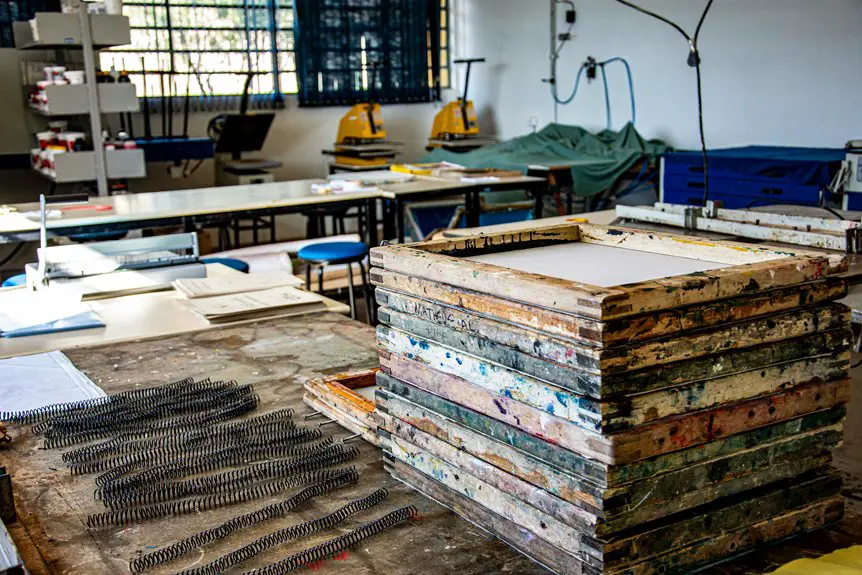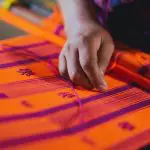Printing on velvet requires careful technique due to its unique texture and pile, which can soften colors and affect ink absorption. You’ll want to choose methods like screen printing for bold designs or heat transfer for intricate patterns, using inks formulated for velvet to guarantee durability and vibrancy. Preparing and securing the fabric properly helps achieve crisp results. If you want to create stunning velvet prints while maintaining fabric softness, exploring the right design choices and care tips will take you further.
Table of Contents
Key Takeaways
- Velvet’s texture and pile height require specialized inks and techniques for clear, vibrant prints without damaging the fabric’s softness.
- Screen printing, heat transfer, digital printing, and flock printing are effective methods tailored to velvet’s unique surface.
- Preparing velvet by gentle cleaning, steaming, and securing flat ensures optimal ink absorption and prevents fabric shifting during printing.
- Use water-based or pigment inks designed for velvet to enhance durability, color vibrancy, and maintain fabric feel.
- Post-print care includes gentle hand washing, air drying, and careful brushing to preserve print quality and fabric texture.
Characteristics of Velvet Fabric Affecting Print Quality
Velvet’s unique texture and pile height greatly influence how prints appear on its surface. When you print on velvet, the dense, raised fibers can cause colors to look softer or slightly muted compared to flat fabrics.
The pile creates uneven surfaces, making it tricky for ink or dye to settle uniformly. Because velvet has a nap that reflects light differently depending on the angle, your design might shift in appearance as the fabric moves.
Additionally, velvet’s plushness can absorb more ink, which may affect color vibrancy and sharpness. You’ll also notice that intricate details might blur due to the pile’s thickness.
Understanding these characteristics helps you anticipate how your prints will look and behave on velvet before you start your project.
Best Printing Techniques for Velvet
Printing on velvet demands techniques that accommodate its textured surface and light-reflecting nap. You need methods that guarantee vibrant colors without damaging the fabric’s softness.
Here are the best printing techniques for velvet:
- Screen Printing – Ideal for bold designs; use specialized inks to prevent clogging the nap.
- Heat Transfer Printing – Works well for intricate patterns; apply heat carefully to avoid crushing the pile.
- Digital Printing – Offers high detail and color variation; choose inks formulated for textured fabrics.
- Flock Printing – Adds texture and depth by applying adhesive and fibers, complementing velvet’s feel.
These options help you achieve vivid, lasting prints while preserving velvet’s luxurious qualities.
Choose the technique that best fits your design needs and production scale.
Preparing Velvet for Printing
Before you start printing, you need to prepare velvet carefully to confirm the design adheres well and the fabric retains its softness.
Begin by gently cleaning the velvet to remove any dust or oils that might interfere with ink absorption. Use a soft brush or lint roller to lift debris without crushing the pile.
Next, press the fabric lightly with a low-heat iron, placing a cloth between the iron and velvet to avoid flattening the texture. If your velvet is particularly thick, consider steaming it to relax the fibers.
Finally, secure the fabric on a flat surface or frame to prevent shifting during printing. These steps confirm your velvet is ready to receive the print without compromising its luxurious feel.
Choosing the Right Ink for Velvet
Once your velvet is properly prepared and secured, selecting the right ink becomes the next priority to confirm your design looks vibrant and lasts. Velvet’s texture demands ink that adheres well without crushing the pile or fading quickly. Here’s what you should consider:
- Fabric Compatibility: Choose inks specifically formulated for velvet or similar plush fabrics to confirm proper absorption and durability.
- Ink Type: Water-based inks offer softness and flexibility, while pigment inks provide better colorfastness and opacity.
- Drying Time: Opt for inks with quick drying times to prevent smudging on velvet’s dense surface.
- Washability: Confirm the ink withstands washing without losing vibrancy or damaging the fabric’s texture.
Picking the right ink protects your design and maintains velvet’s luxurious feel.
Color Selection and Its Impact on Velvet Prints
How do you choose colors that truly pop on velvet’s rich, textured surface? Start by selecting hues with high saturation and contrast; velvet’s pile absorbs light differently, so vibrant colors stand out better than muted tones.
Deep, jewel tones like emerald, sapphire, and ruby often enhance velvet’s luxurious feel, creating a striking visual depth. Keep in mind that lighter shades may appear dull or washed out due to velvet’s texture, so use them sparingly or paired with richer colors.
Also, test your colors under various lighting conditions since velvet interacts uniquely with light, influencing how colors appear. By carefully considering color intensity and contrast, you’ll guarantee your prints maintain clarity and richness, fully leveraging velvet’s tactile beauty without losing vibrancy.
Design Patterns That Work Well on Velvet
Choosing the right colors sets the stage, but the design patterns you pick bring your velvet prints to life.
The right colors lay the foundation, while patterns breathe life into your velvet prints.
When working with velvet, you want patterns that enhance its texture without overwhelming it. Here are four design patterns that work well:
- Floral motifs: Soft curves complement velvet’s plush surface beautifully.
- Geometric shapes: Clean lines provide contrast, adding modern appeal.
- Abstract art: Blended colors and irregular shapes highlight velvet’s depth.
- Baroque or damask: Intricate, elegant patterns enhance velvet’s luxurious feel.
Challenges in Printing on Velvet and How to Overcome Them
Printing on velvet can be tricky because its soft surface texture affects how ink settles.
You’ll need to adjust your ink absorption techniques to guarantee the design stays sharp and vibrant.
Let’s explore how to tackle these challenges effectively.
Velvet Surface Texture
Because velvet has a unique pile surface with raised fibers, it presents distinct challenges when you try to print on it. The texture can cause uneven ink distribution and smudging, making fine details hard to achieve. To get around this, you need to take into account the fabric’s surface carefully.
Here are four key factors to keep in mind:
- Pile Direction: Printing against the pile may distort the design, so always align your print with the nap.
- Fiber Density: Dense piles absorb ink unevenly; adjust print pressure accordingly.
- Surface Softness: Soft velvet can shift during printing; secure the fabric to prevent movement.
- Print Resolution: Use lower resolution or bolder designs to compensate for texture interference.
Understanding these helps you print clearer, more vibrant designs on velvet.
Ink Absorption Techniques
The unique texture of velvet doesn’t just affect how your design looks—it also impacts how the fabric absorbs ink. Velvet’s pile traps ink unevenly, causing blotchy prints if you’re not careful.
To tackle this, you’ll want to use specially formulated inks designed for fabric with thick textures. Pre-treating velvet with a fixative can help control ink spread, ensuring sharper details.
Also, consider using heat transfer or sublimation printing, as these methods allow the ink to bond with the fabric beneath the pile, reducing absorption issues. Avoid heavy ink layers, which can saturate the fabric and damage its softness.
Post-Printing Care and Maintenance of Velvet Fabrics
Once you’ve finished printing on velvet, you’ll want to handle the fabric with care to preserve the colors and texture.
Proper maintenance guarantees your designs stay vibrant and the fabric retains its softness. Here’s how to care for your printed velvet:
- Avoid Machine Washing: Hand wash gently with cold water and mild detergent to prevent damage.
- Air Dry Only: Lay the fabric flat to dry; avoid direct sunlight to prevent fading.
- Brush Carefully: Use a soft brush to maintain the velvet’s pile and prevent matting.
- Iron with Caution: If needed, iron on the reverse side using a low heat setting and a pressing cloth.
Following these steps helps maintain the integrity of both the print and the velvet’s luxurious feel.
Sustainable Practices in Velvet Fabric Printing
When you choose sustainable practices in velvet fabric printing, you not only protect the environment but also enhance the quality and longevity of your creations.
Start by selecting eco-friendly inks like water-based or natural dyes that reduce harmful chemical use. Opt for digital printing methods, which minimize water and energy consumption compared to traditional techniques.
Reuse and recycle fabric scraps to reduce waste, and work with suppliers committed to sustainable sourcing. Additionally, avoid over-washing velvet prints to preserve vibrancy while conserving water.
Implement energy-efficient drying processes, such as air drying when possible. By adopting these conscious choices, you promote responsible manufacturing, reduce your carbon footprint, and create velvet prints that appeal to environmentally aware customers, all while maintaining the luxurious texture and appearance that velvet demands.
Frequently Asked Questions
Can Velvet Fabric Be Printed at Home With Standard Printers?
Printing on velvet with standard printers is like fitting a square peg in a round hole—it’s tricky. You can’t print directly at home; velvet’s texture and fabric type require special techniques beyond usual inkjet or laser printers.
How Does Velvet Printing Compare Cost-Wise to Other Fabric Printing?
Velvet printing usually costs more than printing on cotton or polyester because it requires specialized inks and techniques. You’ll spend extra on materials and equipment, but the luxurious feel and look often justify the higher price.
Are There Specific Velvet Types Better Suited for Upholstery Printing?
Imagine choosing a velvet like picking a trusty steed—crushed and velour types suit upholstery best, offering durability and depth. You’ll want plush, dense fibers that hold prints well without fading under daily wear and tear.
Can Printed Velvet Be Used for Outdoor Applications?
You shouldn’t use printed velvet outdoors because it’s prone to damage from moisture, sunlight, and dirt. If you want durability outside, consider fabrics specifically designed for outdoor use—they’ll last much longer and maintain their appearance better.
What Is the Typical Drying Time After Printing on Velvet?
Before smartphones, drying velvet after printing usually takes about 24 hours at room temperature. You’ll want to avoid rushing it—patience guarantees the ink sets properly and your velvet stays soft and vibrant.






